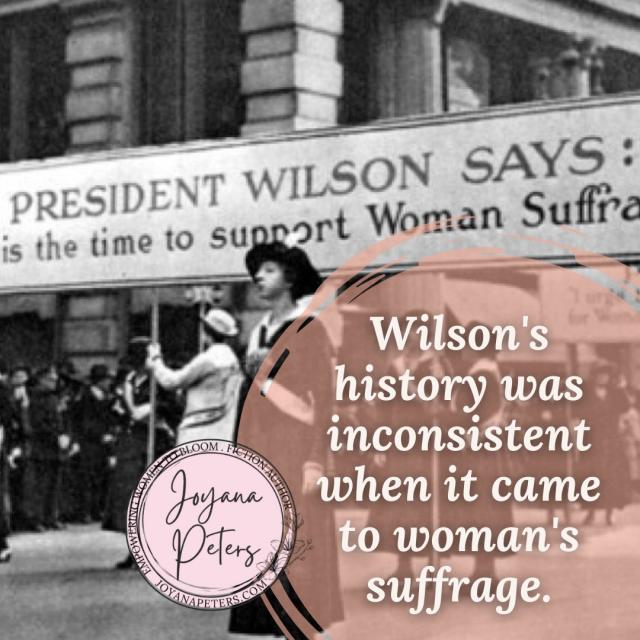As an Amazon Associate I earn from qualifying purchases.
“We march today to give evidence to the world of our determination, that this simple act of justice shall be done.” Woman Suffrage March program
Woman Suffrage Parade on March 3 1913
Woman’s Suffrage has a long and difficult history. As we know, there were many who suffered blood, sweat and tears to advocate for woman’s suffrage. Today I’m going to discuss a particular instance in our Woman’s Suffrage history. The Woman Suffrage Parade on March 3 1913 was supposed to be a peaceful march in Washington DC. However, it unfortunately turned into a day of disaster. What happened and why?
The Plan for the Woman Suffrage Parade
On the week of March 4, 1913, everyone gathered for Woodrow Wilson’s Inauguration Day. Wilson’s history was inconsistent when it came to woman’s suffrage. Wilson claimed to be a Woman Suffrage supporter. However, he believed the states should grant access instead of the federal level. The National American Woman Suffrage Association disagreed.
Lucy Burns and Alice Paul were the newly-appointed chairs of the NAWSA’s Congressional Committee. Paul and Burns wanted more than patchwork woman’s suffrage rights on the state level. They wanted to aim bigger and get the Susan B. Anthony amendment for women’s federal voting rights to pass in Congress. They would do this by shining a spotlight on their cause, making it impossible to ignore.
Paul and Burns carefully planned a Parade to demonstrate their cause. They chose to march along Pennsylvania Avenue, the same route Wilson would take the following day for his Inauguration and got thousands of women to march from all across the country.
The Great Demand
Inez Milholland, a famous suffragette, led the parade riding astride a white horse. She wore a white dress and a tiara with the star of hope. “We’re feminists, fighting not just for the vote, but for full equality,” she declared. In addition to Milholland, the parade also featured floats bearing banners for “The Great Demand.”
In keeping with Paul and Burn’s goal of making the parade impossible to ignore, they chose the parade’s slogan carefully. They coined The Great Demand slogan to exemplify that women were more than just demure and gracious. Women were strong and “demanding” access to the equal rights they deserved.
They next divided the parade into sections with orchestrated examples of woman capability. They designed the procession to demonstrate women’s achievements across the nation and how much they already contributed to the country. To do this women marched in their academic regalia from their universities, in uniforms and with others from their professions, and drove their cars. Behind them bands marched and played patriotic music.
Where Things Went Wrong
Few attendees saw the parade in its intended design, however, despite Paul and Burns’ careful planning. A crowd of over 250,000 spectators had turned up to view the parade. But there was little to no crowd control along the route. Spectators abandoned the sidewalks and blocked the route. The marchers tried their best to continue, those in cars or on horseback tried to push back the crowd. But the crowd immediately filled in again. Eventually, the parade stalled.
The marchers found themselves trapped in a crowd of mainly men that turned extremely hostile against them. The crowd jeered and threw things at the marchers. The men grabbed at the marchers, spitting and yelling sexual insults. The women received no assistance from nearby police officers.
Although a few women fled the scene, most were determined to continue and finish the parade. They locked arms and pushed their way through the ambush. Some used their banners and flags as weapons to ward off further attack. They held their ground until U.S. Army troops finally arrived an hour later to clear the street so the parade could continue.
A Key Moment in Suffrage History
Although the parade did not have its “intended” effect, it did still shine a spotlight on the cause. Headlines detailing the disruption and chaos at the parade eclipsed Wilson’s Inauguration coverage. There were also later inquiries in Congress into why there was insufficient crowd control for the event. These investigations kept the parade in the headlines for months to come which brought much needed interest and support to the cause.
I’ll be speaking next week at the Lucy Burns Museum in Lorton, VA. Check out my event listing here to come and join me!
To celebrate this, I’ll be sharing a follow up blog post next week to further delve into Lucy Burns and her personal champion efforts to support the suffrage cause.
Did you enjoy this article? Check out more of my Changemaker History Posts below!
Find more ways to spoil your inner bookworm!
Check out the Amaryllis Co. Shop, fully stocked with custom designs perfect for every book loving Amaryllis Girl! From shirts, mugs, wine glasses, and more, I have curated a shop with all of my favorites! SHOP HERE! You can also find my collection of bookish merchandise on Etsy.
Are you a VIP Member yet? If you’re interested in seeing Joyana’s Bonus content and ALL of her past newsletters make sure you sign up today! JOIN HERE.
Make sure you are the first to hear when I release a new book or novella! Subscribe to my blog below to never miss an update!
Subscribe
Privacy Policy
The post Woman Suffrage Parade on March 3 1913 appeared first on Joyana Peters.

